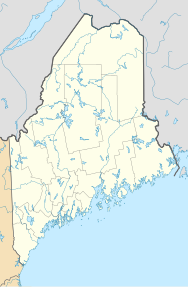South Berwick
| South Berwick, Maine | |
|---|---|
| Town | |

Central Square c. 1910
|
|
| Location within the state of Maine | |
| Coordinates: 43°14′04″N 70°49′30″W / 43.23444°N 70.82500°W | |
| Country | United States |
| State | Maine |
| County | York |
| Settled | 1631 |
| Incorporated | 1814 |
| Government | |
| • Type | Town Council |
| • Town Manager | Perry A. Ellsworth |
| • Town Councilmen | Chairman: Gerald W. MacPherson Sr. Jean Demetracopoulos David H. Webster John C. Kareckas Russell H. Abell |
| Area | |
| • Total | 32.64 sq mi (84.54 km2) |
| • Land | 32.13 sq mi (83.22 km2) |
| • Water | 0.51 sq mi (1.32 km2) |
| Elevation | 43 ft (31 m) |
| Population (2010) | |
| • Total | 7,220 |
| • Estimate (2012) | 7,261 |
| • Density | 224.7/sq mi (86.8/km2) |
| Time zone | Eastern (UTC-5) |
| • Summer (DST) | Eastern (UTC-4) |
| ZIP code | 03908 |
| Area code(s) | 207 |
| FIPS code | 23-70030 |
| GNIS feature ID | 0582732 |
| Website | www |
South Berwick is a town in York County, Maine, United States. The population was 7,220 at the 2010 census. South Berwick is home to Berwick Academy, a private, co-educational university-preparatory day school founded in 1791. It is part of the Portland–South Portland–Biddeford, Maine metropolitan statistical area.
The area was called Newichawannock by the Abenaki Indians, meaning "river with many falls," a reference to the Salmon Falls River. It was first settled by Europeans about 1631 as a part of Kittery known as Kittery North Parish. Near the confluence with the Great Works River, Ambrose Gibbons built the Great House at Newichawannock, a palisaded trading post, to exchange goods with the Indians.
In 1634, William Chadbourne, James Wall, and John Goddard arrived from England aboard the ship Pied Cow to build a sawmill and gristmill at Assabumbadoc Falls. The first houses built in South Berwick were built by Chadbourne and Wall. Chadbourne's house was in the northwesterly angle of Brattle Street and Dow Highway (Rt. 236). Richard Leader, an engineer, rebuilt the sawmill in 1651 to handle up to 20 saws. The factory became known as the "Great mill workes," from which the Great Works River derives its name. It was run by 25 Scottish prisoners of war captured by Oliver Cromwell's forces at the 1650 Battle of Dunbar, then transported aboard a vessel called Unity to Massachusetts. They were sold as slaves whose labor would earn them freedom. The community was dubbed the Parish of Unity after the boat.
...
Wikipedia

